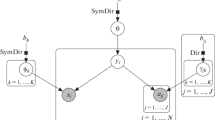Abstract
Information extraction from HTML documents requires a classifier capable of assigning semantic labels to the words or word sequences to be extracted. If completely labeled documents are available for training, well-known Markov model techniques can be used to learn such classifiers. In this paper, we consider the more challenging task of learning hidden Markov models (HMMs) when only partially (sparsely) labeled documents are available for training. We first give detailed account of the task and its appropriate loss function, and show how it can be minimized given an HMM. We describe an EM style algorithm for learning HMMs from partially labeled data. We then present an active learning algorithm that selects “difficult” unlabeled tokens and asks the user to label them. We study empirically by how much active learning reduces the required data labeling effort, or increases the quality of the learned model achievable with a given amount of user effort.
Access this chapter
Tax calculation will be finalised at checkout
Purchases are for personal use only
Preview
Unable to display preview. Download preview PDF.
Similar content being viewed by others
References
T. Berners-Lee. Semantic web road map. Internal note, World Wide Web Consortium, 1998.
T. Brants. Cascaded markov models. In Proceedings of the Ninth Conference of the European Chapter of the Association for Computational Linguistics, 1999.
D. Cohn, Z. Ghahramani, and M. Jordan. Active learning with statistical models. Journal of Artificial Intelligence Research, 4:129–145, 1996.
Mark Craven, Dan DiPasquo, Dayne Freitag, Andrew K. McCallum, Tom M. Mitchell, Kamal Nigam, and Seán Slattery. Learning to construct knowledge bases from the World Wide Web. Artificial Intelligence, 118(1-2):69–113, 2000.
L. Eikvil. Information extraction from the world wide web: a survey. Technical Report 945, Norwegian Computing Center, 1999.
S. Fine, Y. Singer, and N. Tishby. The hierarchical hidden markov model: Analysis and applications. Machine Learning, 32:41–64, 1998.
Ralph Grishman and Beth Sundheim. Message understanding conference-6: A brief history. In Proceedings of the International Conference on Computational Linguistics, 1996.
Thomas Hofmann and Joachim M. Buhmann. Active data clustering. In Advances in Neural Information Processing Systems, volume 10, 1998.
N. Hsu and M. Dung. Generating finite-state transducers for semistructured data extraction from the web. Journal of Information Systems, Special Issue on Semistructured Data, 23(8), 1998.
Anders Krogh and Jesper Vedelsby. Neural network ensembles, cross validation, and active learning. In Advances in Neural Information Processing Systems, volume 7,pages 231–238, 1995.
N. Kushmerick. Wrapper induction: efficiency and expressiveness. Artificial Intelligence, 118:15–68, 2000.
Andrew McCallum, Dayne Freitag, and Fernando Pereira. Maximum entropy Markov models for information extraction and segmentation. In Proceedings of the Seventeenth International Conference on Machine Learning, 2000.
L. Rabiner. A tutorial on hidden markov models and selected applications in speech recognition. Proceedings of the IEEE, 77(2):257–285, 1989.
T. Scheffer, S. Hoche, and S. Wrobel. Learning hidden markov models for information extraction actively from partially labeled text. Technical report, University of Magdeburg, 2001.
Kristie Seymore, Andrew McCallum, and Roni Rosenfeld. Learning hidden markov model structure for information extraction. In AAAI’99 Workshop on Machine Learning for Information Extraction, 1999.
V. Vapnik. Statistical Learning Theory. Wiley, 1998.
Author information
Authors and Affiliations
Editor information
Editors and Affiliations
Rights and permissions
Copyright information
© 2001 Springer-Verlag Berlin Heidelberg
About this paper
Cite this paper
Scheffer, T., Decomain, C., Wrobel, S. (2001). Active Hidden Markov Models for Information Extraction. In: Hoffmann, F., Hand, D.J., Adams, N., Fisher, D., Guimaraes, G. (eds) Advances in Intelligent Data Analysis. IDA 2001. Lecture Notes in Computer Science, vol 2189. Springer, Berlin, Heidelberg. https://doi.org/10.1007/3-540-44816-0_31
Download citation
DOI: https://doi.org/10.1007/3-540-44816-0_31
Published:
Publisher Name: Springer, Berlin, Heidelberg
Print ISBN: 978-3-540-42581-6
Online ISBN: 978-3-540-44816-7
eBook Packages: Springer Book Archive




